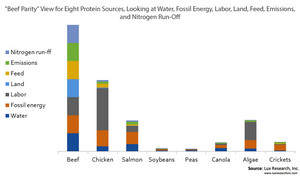BOSTON, MA--(Marketwired - Nov 11, 2015) - Protein is a critical nutrient in our diets, but one of the most resource-intensive to produce. As the world population grows and resource restrictions loom, protein security -- creating sufficient protein for our growing population -- is becoming a critical issue for companies, consumers, and nations, according to Lux Research.
Lux found that beef is the most resource-intensive to produce, consuming far more fossil fuels than rival protein sources such as chicken and salmon. It takes 380 megajoules (MJ) of primary energy, the equivalent of nearly three gallons of gasoline, to produce one kilogram of beef protein. In comparison, chicken and salmon require only 340 MJ/kg and 260 MJ/kg, respectively, per kilogram of protein.
"To gauge protein security concerns, we use the concept of 'beef parity' -- a measure of all of the resources needed to produce 1 kg of beef protein -- as a benchmark for the resource burden of other forms of protein," said Camilla Stice, Lux Research Analyst and lead author of the report titled, "De-risking Protein Strategies Using a Systems Approach: A Novel Analytical Framework."
"Our analysis demonstrates that there is no 'one size fits all' solution to protein resource use intensity. No single protein source emerges as a runaway winner, and each analyzed source has opportunities for improvement -- whether in protein quality, ease of production, or overall resource intensity. Small changes to production can have cascading impacts throughout the supply chain that could mitigate resource risk or make it worse," she added.
Lux Research analysts built an analytical framework to measure and benchmark resource consumption for the production of both conventional and alternative protein sources. Among their findings:
- Water determines canola's efficiency. Canola's protein yield is roughly equivalent to soy on a percentage basis and its quality is comparable. However, assumptions about irrigation rates play a key role in determining whether its resource use is greater or less than other land-based crops. Also, waste nitrogen run-off after fertilizer application is a significant concern.
- Algae's potential remains murky. Algae biomass needs less land area, but its economic viability is highly dependent on minimizing electricity requirements for growth, harvesting, and processing. However, real pilot-scale production data is scarce and disagreement among some model's data is so extreme as to render them useless.
- Geographies play a major role in risk. The scarcity and pricing of many of the inputs for protein production varies by geography. Knowing how resource use relates to the relative availability and cost of that resource, especially within a given geography, will help producers identify the most attractive proteins by region.
The report, titled "De-risking Protein Strategies Using a Systems Approach: A Novel Analytical Framework," is part of the Lux Research Food & Nutrition Intelligence and Agro Innovation Intelligence services.
About Lux Research
Lux Research provides strategic advice and ongoing intelligence for emerging technologies. Leaders in business, finance and government rely on us to help them make informed strategic decisions. Through our unique research approach focused on primary research and our extensive global network, we deliver insight, connections and competitive advantage to our clients. Visit www.luxresearchinc.com for more information.
Contact Information:
Contact:
Carole Jacques
Lux Research, Inc.
617-502-5314
carole.jacques@luxresearchinc.com
